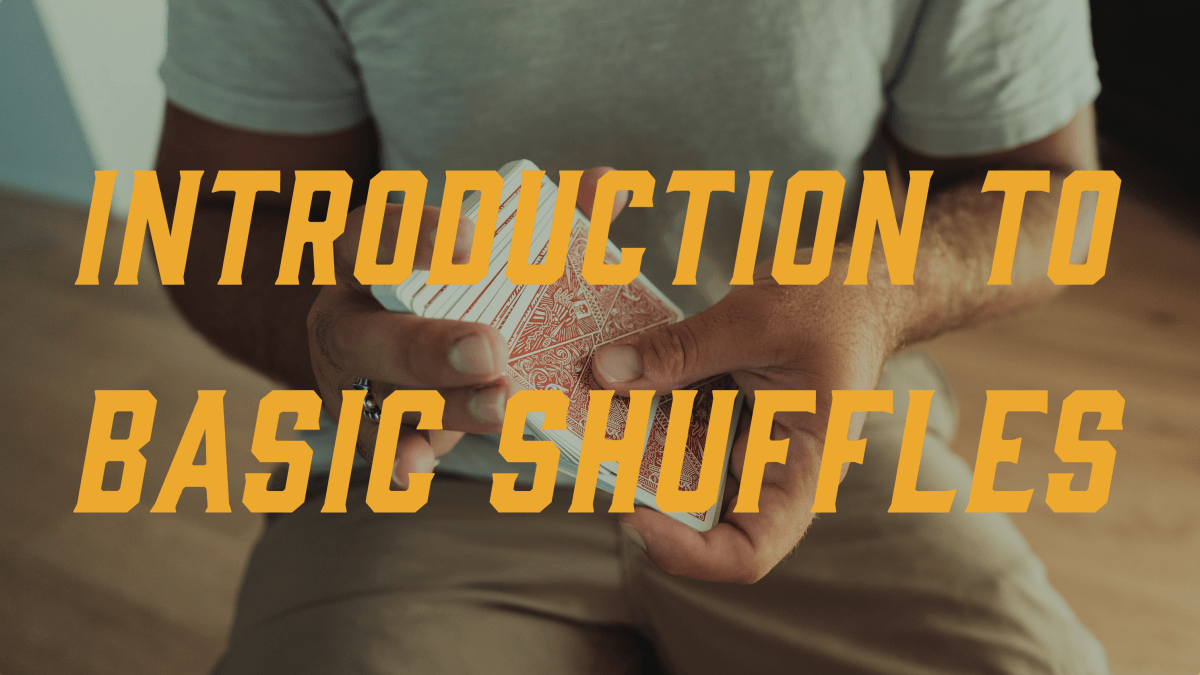3 Ways to Shuffle a Deck of Cards

Ever been in the situation where you have to shuffle a deck of playing cards? That sudden nervousness as you look up at your friends and coyly say, “Oh, I’m not very good at shuffling.” The embarrassment. That ends now. From now on, you’ll shuffle a deck of cards like a pro and leave all of your friends impressed. We think being able to prepare playing cards for a game is a life skill that everyone should have.
So, let’s go through the 3 most popular methods of shuffling a deck of playing cards.
The Overhand Shuffle

Let’s start with the most basic, the Overhand Shuffle. This is the most common and is used around the world!
Step 1:
Hold the deck of cards horizontally in your dominant hand, this is typically called a straddle grip.
Place your middle, ring and pinky finger on the short end of the deck facing away from you. Your index will rest naturally on the long edge on the top side. Your thumb is placed on the opposite short end.
Step 2:
Rest the deck on the palm of the opposite hand. Curl the fingers of the left hand in to support the deck. All the cards should be square and aligned.
Step 3:
The thumb of the left hand should be lightly placed against the surface of the bottom card of the deck. This is to support the deck. Gripping with the thumb, middle and ring finger, split half the deck, lifting the packet away. You should now have a packet in your left hand supported by curled fingers and your left thumb.
The split packet should have the same grip as you begun. Now, place the split packet in front of the packet in your left hand - remember to move the thumb of the left hand to make way for the new packet.
That’s it - now repeat the process, varying the number of cards and the size of packets that you split as you shuffle the deck.
This shuffle can be a little awkward at first, but with a little practice, it will look clean. And most importantly you will look like you know what you’re doing - because of course, now you do.
The Riffle Shuffle

Perhaps the most iconic shuffle in the world. It is instantly recognisable and has a bonus effect of making all your friends jealous when they see you perform it - simply because you now possess mad skills.
Step 1: Let’s get to grips
Grip the deck in your left hand in what’s called an elevated Dealer’s grip. Your ring, middle and pinky fingers should be on the longest edge of the deck facing away from you. The index should rest on the short edge furthest from you. The thumb on the opposite long edge closest to you.
With your right hand - Place the ring, middle, and pinky on the short edge of the deck where the index of your left hand was places. Your right index should be curled with the knuckle resting on the top of the deck. Your right thumb place on the short edge.
Step 2: Time to split and riffle
As if you were riffling the pages of a book, run your thumb along the short edge of the deck closest to you - while maintaining pressure from the curled index finger on top and the other fingers keeping the cards square.
You should be now able to release your left hand entirely, having essentially switched grips.
Riffle the cards half way down the deck and stop. The ring, middle and pinky fingers of the right hand are now curled underneath the far short edge. The deck should split into two packets.
With the left hand, you should be now able to grip the split second packet - identical to the right hand.
In your right hand - The ring, pinky and middle finger are curled around the bottom of the furthest short edge of the packet. The index, curled, is still maintaining pressure, and the thumb is on the opposite short edge. You should be able to bow the cards. You should also have the same grip in your left hand with the split packet.
Step 3: Time to weave.
Now that you have two identical packets, it’s time to weave them together. Turning both palms down, bring the edges gripped by the thumbs perpendicular to each other. Maintaining grip with the ring, middle and pinky of both hands - repeat the book riffling motion with both packets, similarly to step one. The index fingers are both curled, providing the necessary pressure to riffle.
The goal is to weave each card together, one on top of the other, in a 1-1 pattern from both packets. You may find that you drop the cards on the first attempt, however, with a solid and consistent grip from the supporting fingers, you should be able to weave the cards in midair.
Step 4: The main event!
Once weaved, and while maintaining grip from your other fingers, move the index fingers from the top of the packets to join the ring, middle and pinky fingers on the bottom. It should look like you’re holding a sandwich.
With the thumbs maintaining pressure where the top two cards are weaved on top of the deck, you can begin to bow the cards into an arch shape. You are now primed to allow gravity to weave the cards together in a cascading fashion.
While maintaining grip on the edges of the packets, and with the thumbs maintaining consistent pressure, release the index, middle, ring and pinky fingers of both hands - thus triggering the cascade.
There! The cards are now shuffled. While it is a finicky flourish to learn, with practice, this will feel natural and smooth.
THE HINDU SHUFFLE

This is probably the easiest of the lot and you’ll master it in no time. It’s similar to the swing cut, which we’re bigger fans of - you can learn that here.
Step 1:
Remember Elevated dealer’s grip? Yeah, well start there in your left hand. But adjust it slightly so that your pinky, ring and middle finger are slightly further to the far end of the deck. Do the same with your thumb. The index stays put. This allows more room to grip the packet in the next step.
Step 2:
Now, with your right thumb and middle finger, come to the bottom of the deck in the left hand and grip approximately half the deck - strip that packet out.
Allow the elevated packet to fall into the palm once the stripped packet has cleared.
Step 3:
Grip the top half of stripped packet with the thumb and middle fingers of the left hand. Repeat the strip motion from the last step and allow the second packet to fall into the palm, falling onto the original packet in the palm.
Step 4:
Repeat this cycle until you run out of cards, and then repeat the process again until you deem the cards to be sufficiently shuffled.
That’s it! Those are the 3 most common shuffling techniques in the world. And with a little bit of practice, you’re going to be able to master them and spare yourself the embarrassment of not knowing how to shuffle a deck when you play with your friends!
Of course, everyone needs a high quality deck to shuffle with. The better the quality, the easier it is to shuffle.







Leave a comment